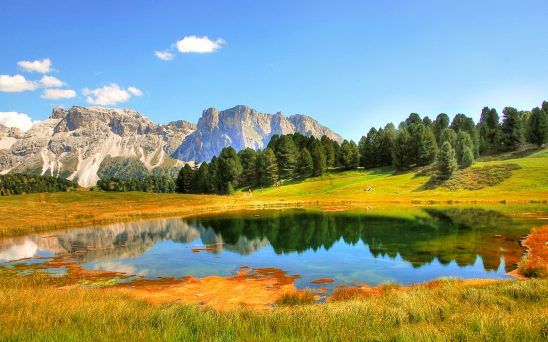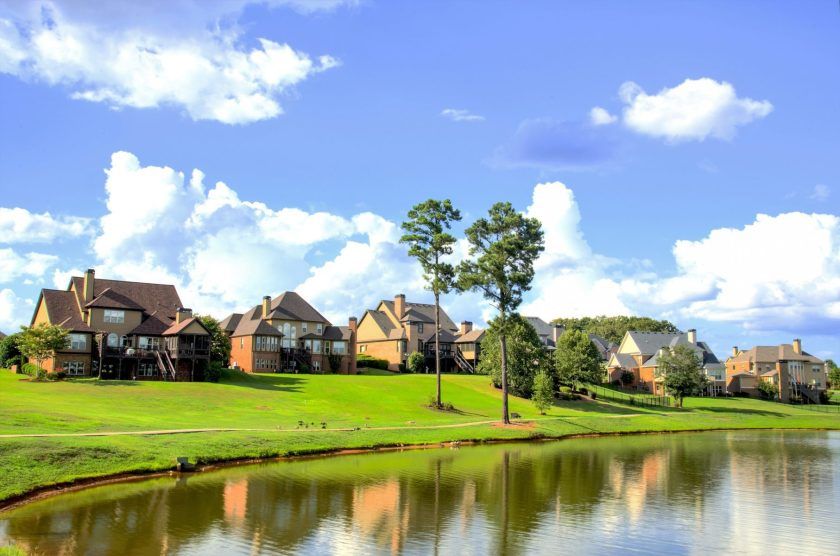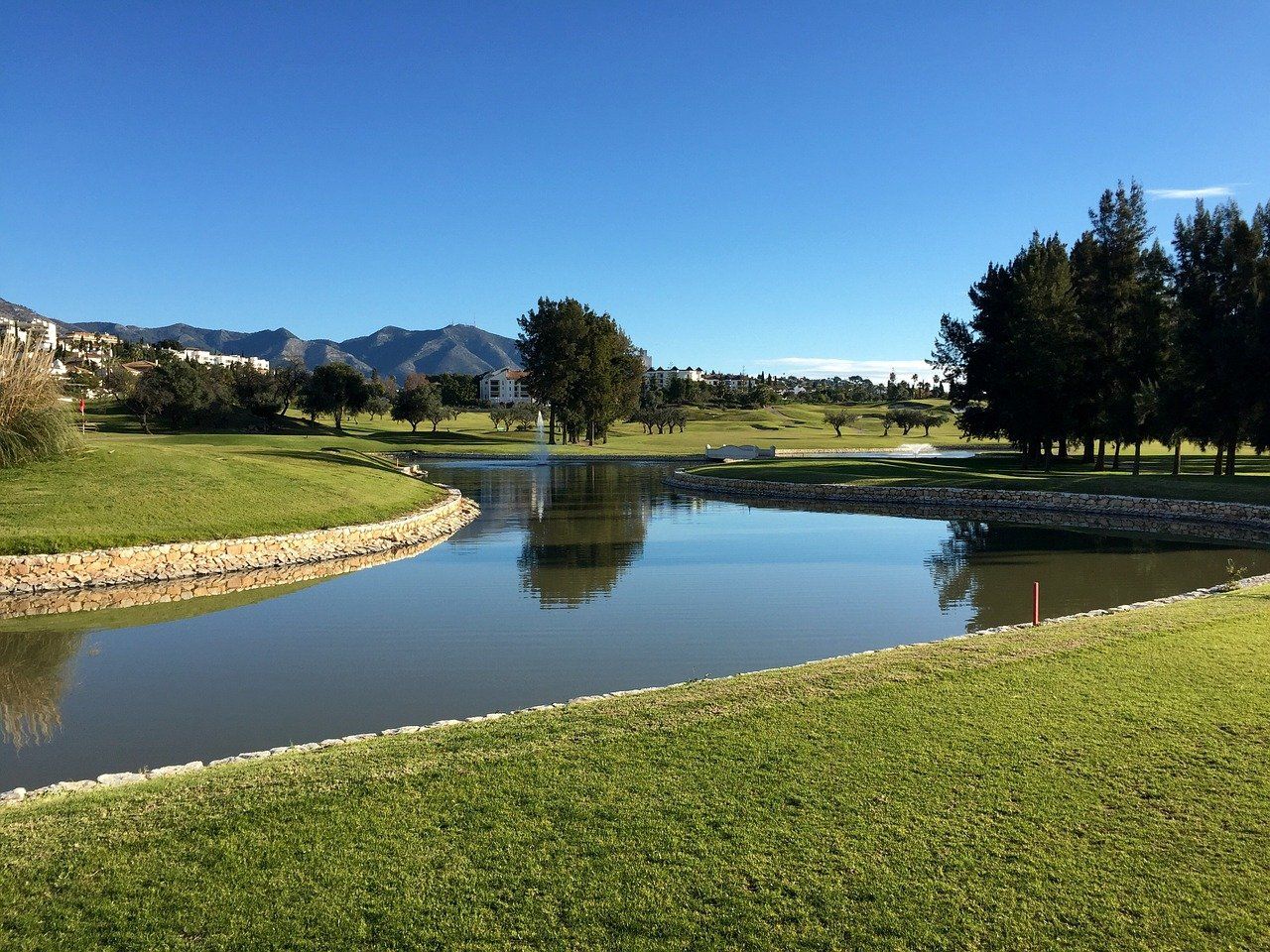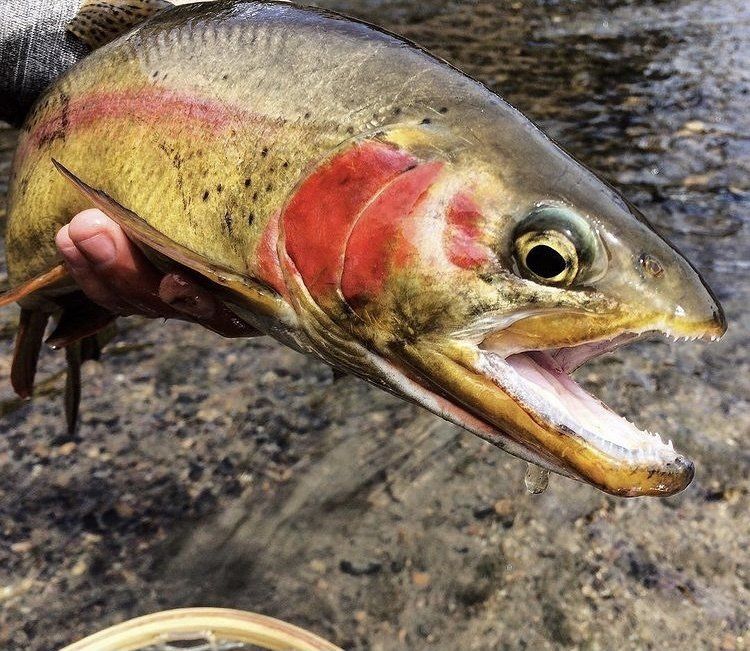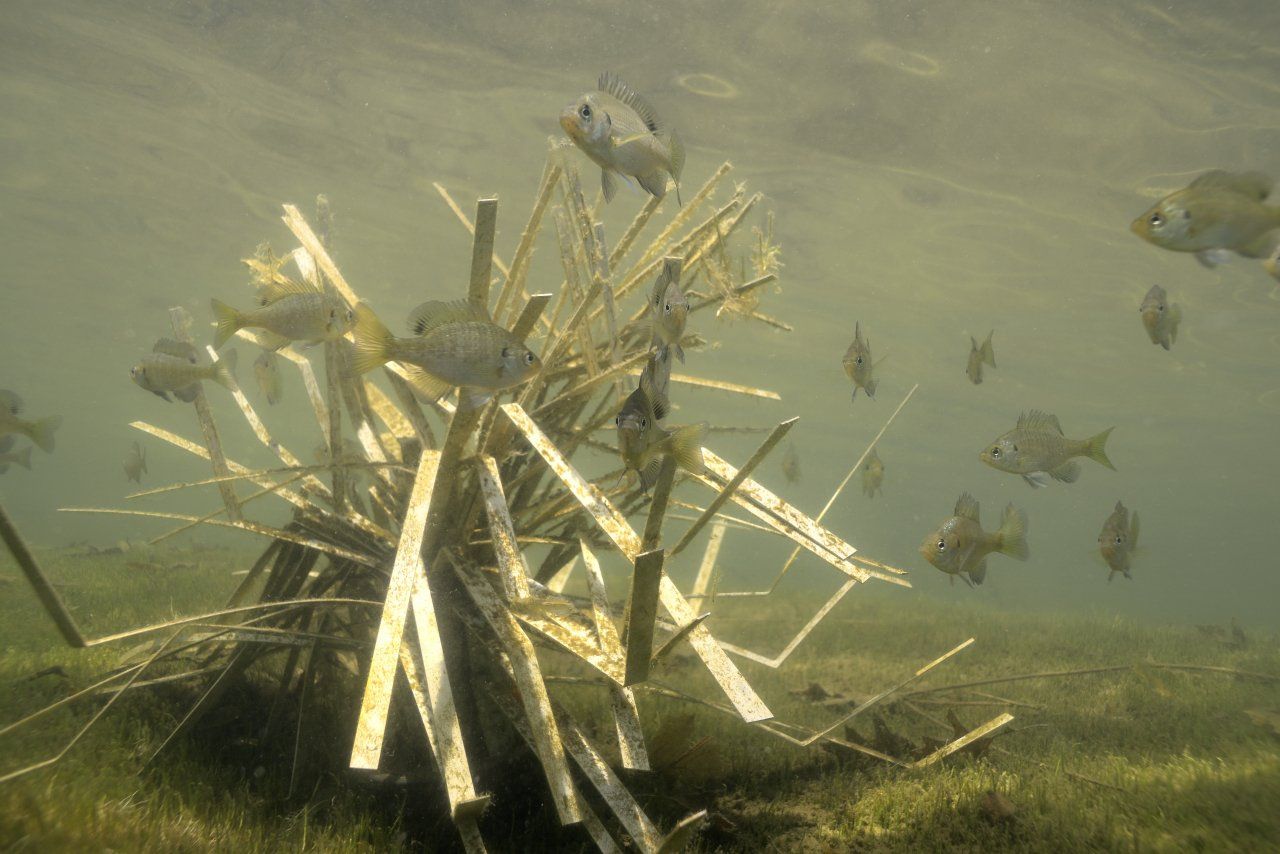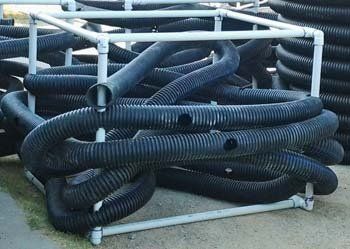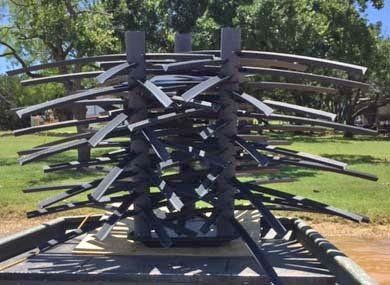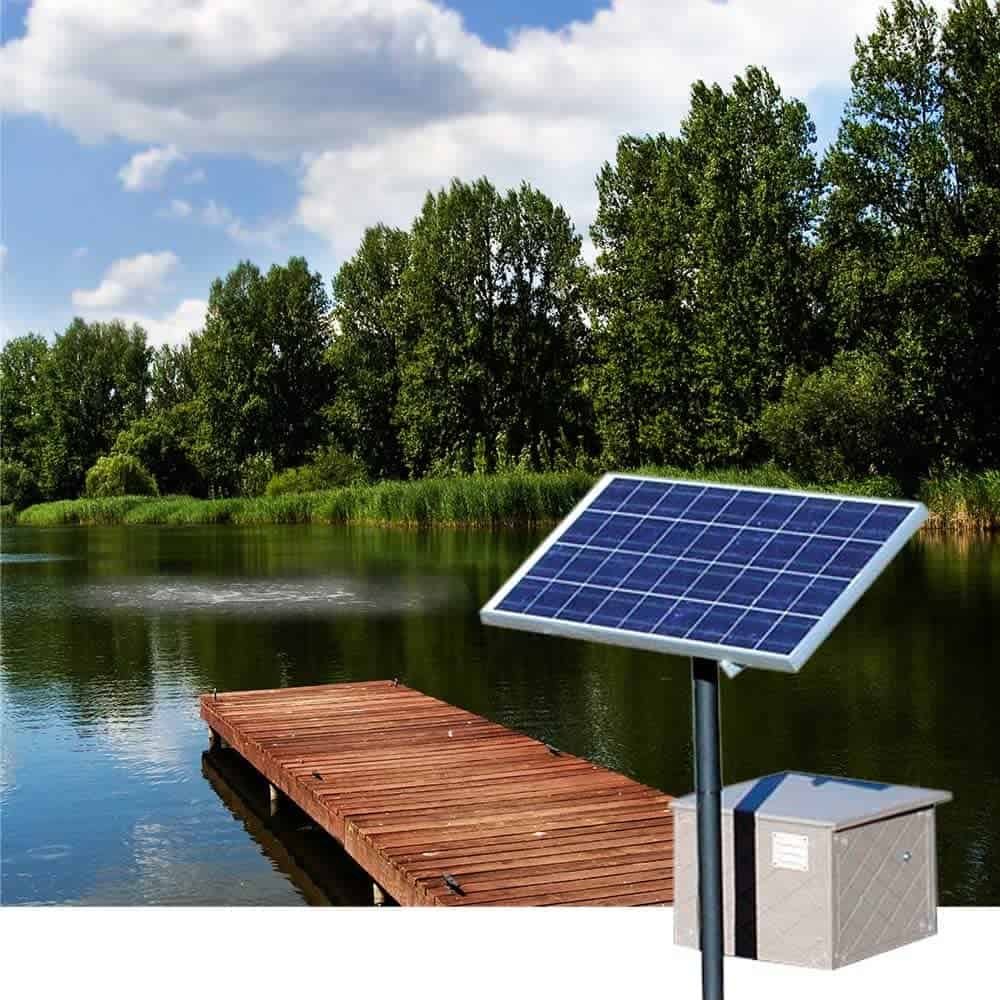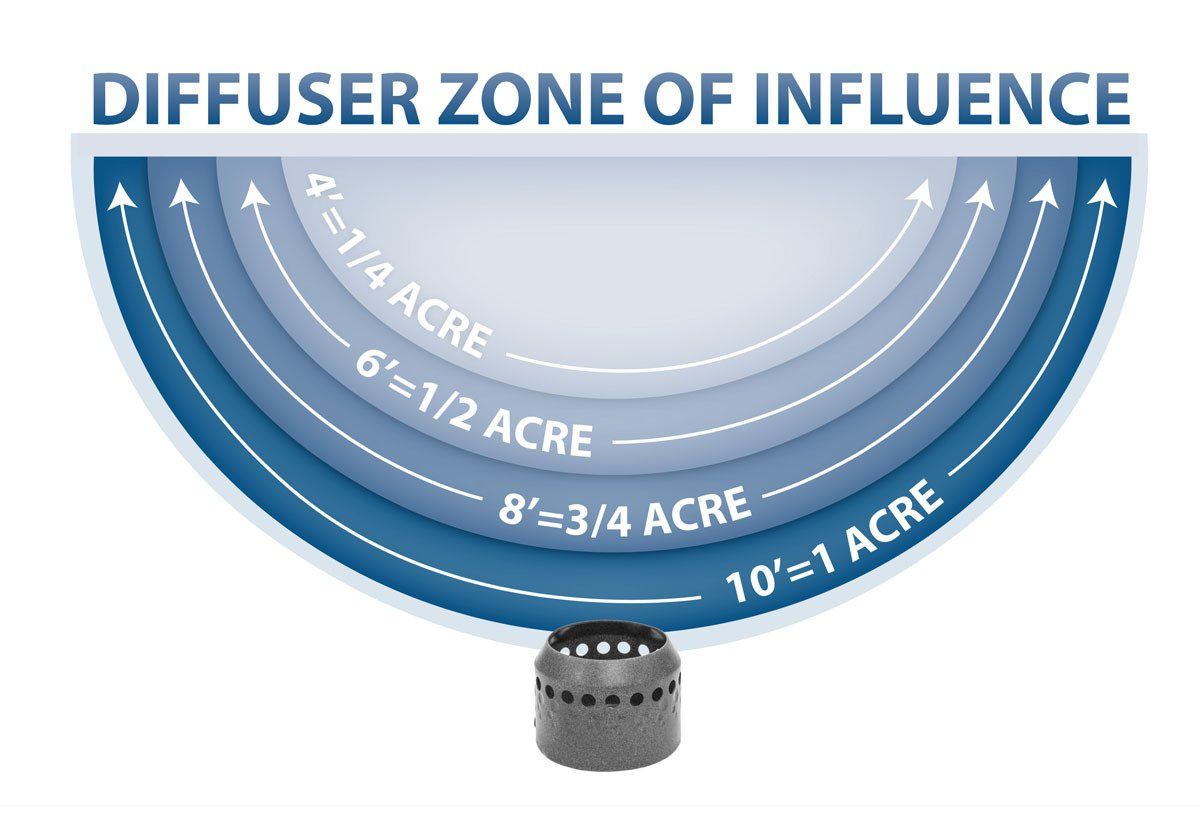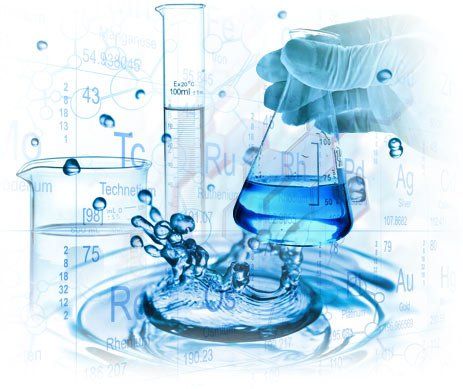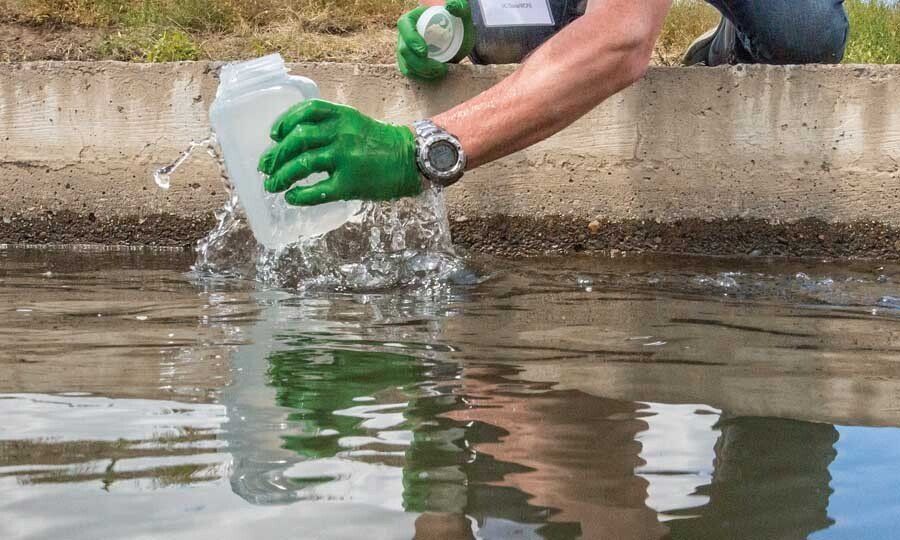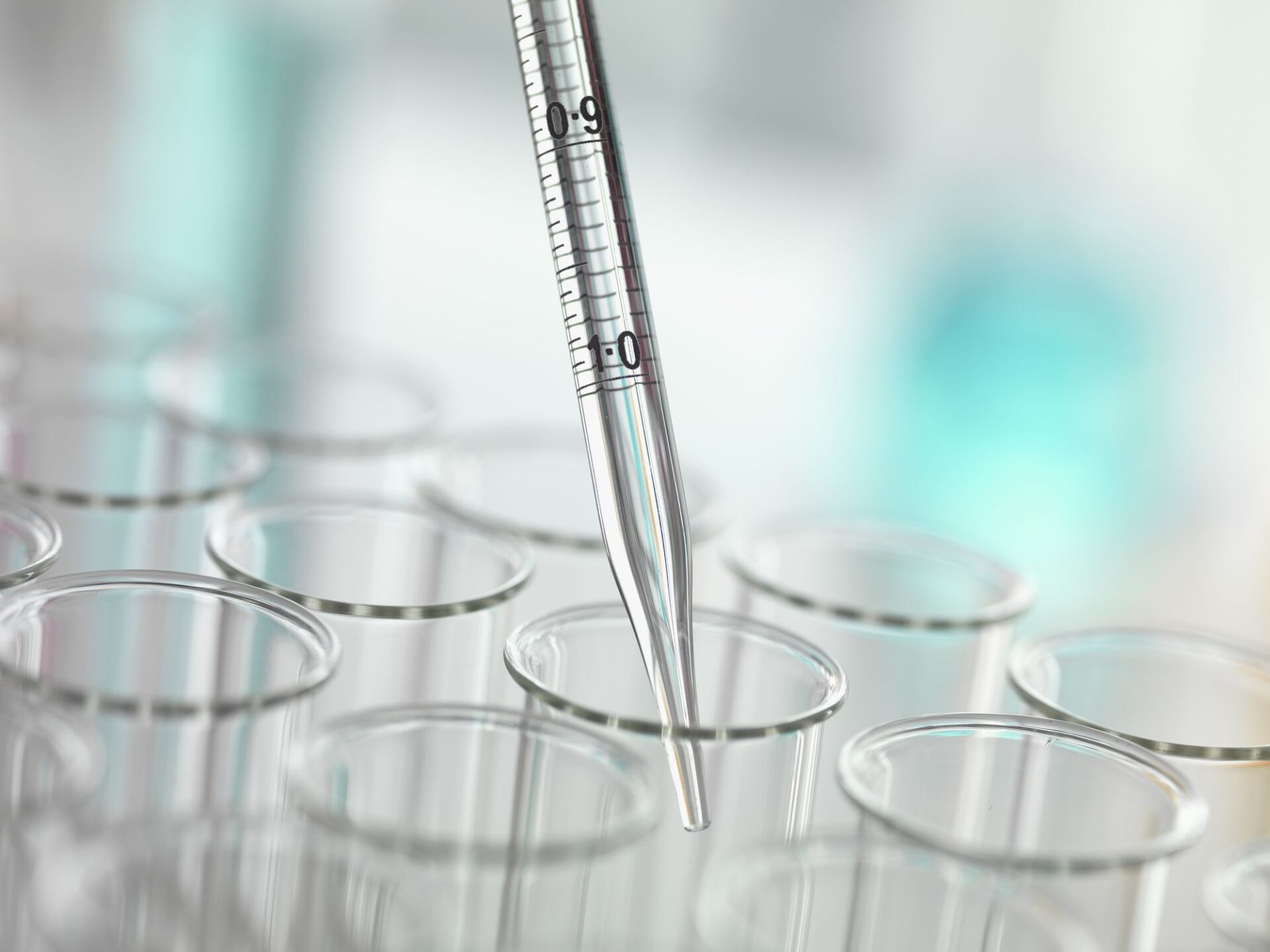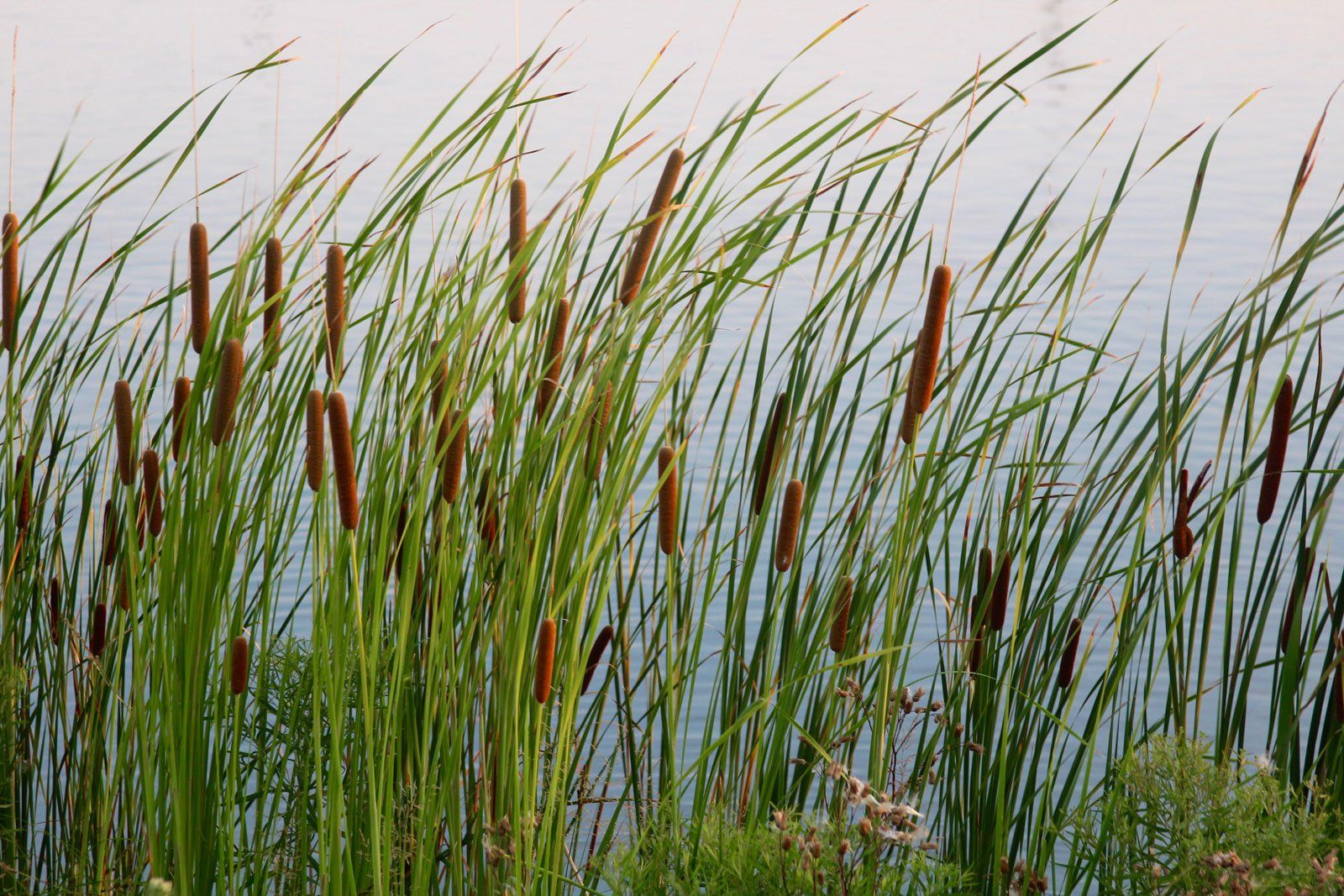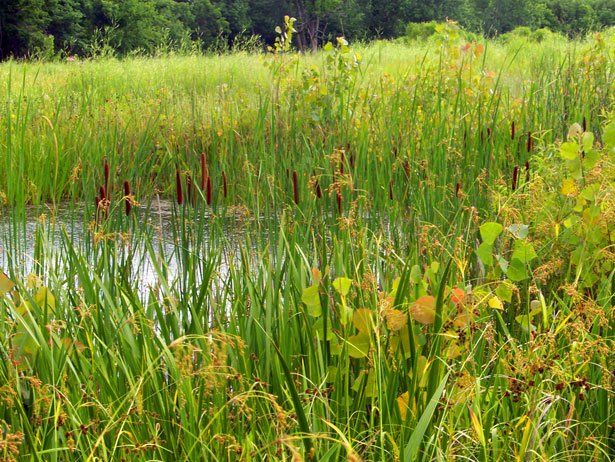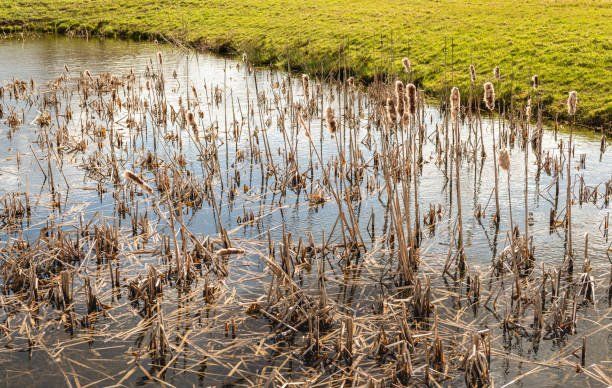Aquatic Management
Aquatic management manifests in many forms depending on the objectives for the resource. Goals can range from achieving aesthetic beauty to establishing a healthy multi-tiered fishery. An array of mechanical, biological, and chemical tools are used to accomplish these management goals. Furthermore, studies such as bathymetry mapping and water quality analysis are used to maximize the effectiveness of management strategies.
The most common goal of aquatic management is to achieve and maintain aesthetic splendor. CPL attains this target through a multi-pronged approach that reduces unsightly aquatic growth and improves water clarity. In almost every circumstance Aeration Systems are recommended to oxygenate the water column, thereby reducing nutrients available for unwanted vegetative and algal growth. Also applied in this spirit are biological agents such as water column clarifying bacteria. These bacteria work by out-competing algae and vegetation in nutrient uptake. They are added to a water body in both liquid and solid forms on a regimented basis. This is to maintain a healthy, working bacterial population throughout the growing seasons. Pelletized bacteria may also be added in intervals to consume excessive pond sludge.
CPL prefers to rely on the above proactive management strategies, however the use of chemical algaecides and herbicides are often supplemented for immediate reductions in unwanted growth. These chemicals work by interfering with plant and algae photosynthesis or by destroying critical cell structures. Additionally, aquatic dye may be utilized depending on the desired appearance of a waterbody. Aquatic dye works by distorting the photosynthetic layer, rendering sunlight unavailable for aquatic growth. All of Colorado Pond and Lake's chemical applicators are state certified and always distribute chemicals in an environmentally friendly manner, especially in regard to fish health.
Another common goal of aquatic management is the establishment of multi-tiered fisheries. The purpose of a multi-tiered fishery is to stock multiple species, some of which engage in a predator/prey relationship, in a single body of water. These fisheries are capable of sustaining several species of sport fish and their bait fish or forage base counterparts. The individual species in these fisheries may also serve larger management purposes. For instance, Fathead Minnows feed on mosquito larvae, thereby mitigating the nuisance insect's propagation. Triploid Grass Carp are great natural reducers of aquatic vegetation. At the peak of their metabolism (between the ages of 2-8 years old) they are capable of eating more than their body weight in vegetation every single day. For more information on fisheries please read below in Fish Stocking and Fish Habitat.
To maximize the effectiveness of management strategies and to accurately determine appropriate fish stocking densities, it is often necessary to gain a deeper understanding of a water body through bathymetry mapping and
Water Quality Analysis.
Bathymetry is the mapping of a waterbody through the use of sonar and physical measurement. The volumetric data yielded from this mapping helps to guide decisions such as the appropriate application rates of biological/chemical treatments and the ecological holding capacity of fish stocking. Water quality analysis assists management in a similar fashion. Understanding the chemical properties of a waterbody allows our specialists the ability to tailor biological/chemical treatments and to ensure the sustainability of fish stocking. The end gain of these studies are the maximized results and cost-effectiveness of aquatic treatment and expertly informed fish stocking.
Contact us today and our consultants will develop a management plan to achieve all of your aquatic needs.
Fish Stocking
There are many reasons to establish a fishery in your aquatic resource. Primarily, our clients are interested in fisheries for recreation and aquatic management. Our team at Colorado Pond and Lake is skilled at helping you determine which species and stocking densities are appropriate for your water. Furthermore, with our specialized skill-set, you can be assured that your fish will be healthy when they are hand-stocked into your resource.
Simply put, recreational fishing is FUN! There is no reason more than that needed to establish a vibrant fishery. CPL is adept at collecting and using available data to ensure the correct species and quantities of fish are stocked to achieve the goal of a healthy fishery. Appropriate stocking densities are concluded based on the waterbody's physical location (important to note for climate and elevation), volumetric capacity, and existing fish populations. Additionally, Water Quality Analysis is always recommended before stocking fish to ensure that the chemical properties of the water are suitable for general fish health. Please read below for currently available Fish Species.
Stocking fish can be an effective, natural aquatic management strategy. To reduce mosquito populations, Fathead Minnows consume mosquito larvae thereby curtailing the nuisance insect's propagation. Fathead Minnows also act as a great forage base for Trout, Bass, and other game species. They are preferred over pelletized fish food because of the hardiness they promote in predatory fish and the avoidance of nutrient loading caused by uneaten pellets. Triploid Grass Carp are another fine example of stocking for management purposes. At maturity, these Carp are capable of consuming more than their body weight in vegetative growth daily. Our Carp are certified sterile, in compliance with Colorado state law. This is useful for fisheries management as well, ensuring that populations remain balanced.
To guarantee fish health during transportation from our farms to your water, Colorado Pond and Lake utilizes the best technology and methodology for hauling. Our insulated hauling tanks keep water temperatures ideal throughout transportation. Multiple forms of aeration are also employed to ensure adequate oxygen/carbon dioxide exchange is maintained. Lastly, upon stocking our specialists take the extra step to temper your fish and acclimate them before release.
Please reach out to us today and get the fish stocking process started.
Fish Species
Trout Species: Brook, Brown, Rainbow, Snake River Cutthroat, Tiger, Yellowstone Cutthroat Please inquire about other exotics.
Warm-Water Species: Triploid Grass Carp, Fathead Minnows, Bluegill, Sunfish, Black Crappie, Koi, Channel Catfish, Large Mouth Bass, Hybrid Striped Bass, Yellow Perch, Northern Pike, Muskie, and Walleye.
Fish Habitat Design and Installation
Artificial fish structure serves many valuable roles along side its naturally occurring counterparts. The fish structures manufactured by Colorado Pond and Lake are made of durable, ecologically friendly materials such as vinyl, PVC, and polys. CPL makes an environmental effort to use reclaimed materials for these structures, saving them from the landfill and re-purposing them as beneficial aquatic habitat. Our specialists strategically place the appropriately designed structures where fish naturally congregate and where they will best serve their specific purposes.
A fundamental issue with natural fish structures is that they deteriorate or decompose over time. Stumps, fallen trees, and brush all contribute in their lifespans to serve as habitat for fish and micro-organisms that are vital to the overall health of a well-balanced aquatic ecosystem. However, not only do these structures ultimately collapse, they act as nutrient sources for unwanted aquatic growth and their decomposition creates an oxygen demand that may adversely impact fish health. Artificial structures help to supplement or replace natural habitat. The durable materials they are composed of do not leach into the water and can last lifetimes. Additionally, they can be removed and cleaned as needed.
CPL designs and constructs artificial structures to serve specific purposes. Spawning habitats are designed to encourage fish propagation by introducing ideal substrate for fish eggs and provide shelter from predators. General habitat structures allow a place for fish to loaf during the day and an interior reprieve from predatory fish. These structures also attract the attention of predatory fish, making them ideal angling structures. While the dense interior provides a sanctuary for smaller fish, the exterior supports a hunting ground for trophy fish.
A key facet of successful fish habitat structure is strategic deployment. Our specialists take the time to understand the physical characteristics of your resource in order to place structures where they will be most effective. It is important to realize that habitat is best utilized where fish naturally exist in the aquatic environment, meaning that attracting structure shouldn't be placed simply where you think fish should be. The placement of habitat structure can occur at anytime, whether you are constructing an unfilled waterbody or managing an existing one.
Please reach out to us today and our team will generate habitat designs and an implementation plan to achieve your specific fishery goals.
Aeration Systems
Bottom-diffused aeration can be defined as the introduction of compressed air into the bottom of a pond or lake using a self-cleaning, non-clogging diffuser. When compressed air is released at the bottom it will naturally begin to migrate towards the surface of the water. As it travels up the water column the pressure surrounding the bubbles slowly decreases causing the bubbles to expand in size. Due to the fact that larger bubbles displace more water than smaller bubbles a slight current begins to develop. This current draws oxygen depleted water from the bottom, oxygenates it and transports it to the surface. This action mixes stratified water while increasing dissolved oxygen levels and protecting fish, aquatic organisms and beneficial microbes from suffocation.
Degraded or eutrophic ponds and lakes can be characterized by low levels of dissolved oxygen and highly stratified water (where warm, oxygen-rich water is suspended above cool, oxygen-depleted bottom water). As anaerobic conditions begin to develop in the deeper water, naturally occurring aerobic microbes can no longer perform beneficial tasks, such as waste digestion or water purification. With time, water quality greatly decreases, leading to unsightly blooms of algae, the accumulation of organic sludge and the buildup of gases such as hydrogen sulfide. Low oxygen levels can also lead to fish kills. Bottom-diffused aeration combats low oxygen environments and stratification efficiently and effectively keeping ponds and lakes healthy and safe.
Colorado Pond and Lake proudly offers Kasco Marine©, ProLake™ and Solaer™ aeration systems for every conceivable location and application. Whether you have electricity available or your location is too remote, we've got you covered with a variety of direct power and solar aeration systems. Please click here to review the various systems we offer or simply contact us for a quote today.
Water Quality Analysis
The chemical constituents present in a water body are the underpinning factors that determine the overall heath of an aquatic resource. While most of these compounds and elements are invisible to the naked eye, their presence or absence are the driving forces behind very tangible effects. In order to effectively manage water, it is typically necessary to evaluate and quantify the chemical properties contained within. CPL offers chemical analysis packages which target chemical factors that cause specific issues based on our customers' goals.
In order to gain a deep understanding of an aquatic body, chemical analysis is performed to guide management decisions. Chemical analysis yields data that influences decisions such as what algaecides and pesticides should be applied all the way to what fish should be stocked. It is often recommended, based on the overall management goals, to conduct analysis multiple times a year. Interval sampling, in this context, identifies changes throughout the seasons and allows for the monitoring of historic trends over the years. The more data collected, the better management strategies can be tailored to achieve goals and maximize cost effectiveness.
A wide variety of algaecides, pesticides, catalysts, and enzymes are among the arsenal of chemical tools employed by Colorado Pond and Lake to mitigate unwanted aquatic growth. Several of these chemical and biotic agents have overlapping purposes. One of the reasons for this overlap is due to their varying effectiveness depending on the chemical environment of the water they are applied in. A detailed water quality analysis helps our specialists determine the correct and most effective products for use in your water. Furthermore, vegetative and algal growth in an aquatic resource is dictated by the amounts of different nutrients and metals available in the water column. Identifying the drivers of unwanted aquatic growth, via analysis, adds a prong of knowledge to combat it.
Evermore important in a modern world plagued by aquatic eutrophication, is the ability to identify potentially toxic forms of algal blooms. Our laboratory technicians are capable of identifying and enumerating potentially toxic cyanobacterial strains that may be present in water. These organisms can have adverse health impacts on wildlife, pets, and humans. If your water source is used for recreational activities like swimming or boating, the presence of toxic cyanobacteria is of the utmost concern.
Understanding water quality parameters is vital when stocking fish. Chemical analysis will determine if a water body is suitable for certain fish species. Parameters such as dissolved oxygen, hardness, alkalinity, and metals are key factors in managing a successful fishery. Conducting water quality analysis prior to fish stocking will help us guarantee the health and longevity of your fish.
Please reach out to our team today. We will establish what water quality analysis is appropriate to achieve your goals.
Cattail Removal and Riparian Devolpment
Pond and lake aging is part of the natural life-cycle of an aquatic body. As aquatic features mature, they naturally become more shallow and ultimately transform into wetlands and marshlands. When this occurs, oppressive vegetative species, like Canadian Cattails, thrive and choke out the native flora. There are several ways to mitigate or reverse the effects of this process. As measures are taken in this spirit, it is important to preserve or establish a healthy riparian border. A riparian border can take many forms but in all cases it acts as a buffer between the surrounding landscape and an aquatic body. CPL looks through the scope of a wide lens to ensure that immediate and long term goals are achieved when performing reclamation efforts and subsequent riparian development.
During the life span of an aquatic resource, water depth will shallow and the wetland bench will increase in breadth. The input of filling material is from both internal and external sources. Intuitively, water and wind introduce organic and inorganic materials into water bodies through runoff. Simultaneously, organic processes in the water such as vegetative growth and fish activity contribute to build-up throughout their respective life-cycles. As aquatic resources accumulate these materials, hospitable areas for nuisance vegetation, such as Cattail growth, become established along the encroaching wetland margins.
The initial step in reversing the process of pond and lake aging is to manually remove material. This action can manifest itself in the form of simple Cattail removal or, the more extreme measure, dredging. In the common instance where Cattail removal is the ideal method of reclamation, our specialists use a variety of hand and mechanical tools to cut and withdraw the target vegetation. It is valuable to note that the removal performed by CPL is discriminate, meaning that our trained professionals are capable of distinguishing between desirable plants and unwanted ones. Optionally, enzymes can subsequently be applied on the remaining leaf sheaths to ensure that the root system is destroyed and no regrowth of existing plants will occur. This method of removal will allow water to flow more freely and for the re-establishment of desirable native vegetation to be replanted in effort to create a healthy riparian border. In the extreme circumstances, where sediment accumulation has occurred to the point where simple Cattail removal is insufficient, dredging should be implemented. In these cases, heavy equipment is required to remove large amounts of sediment and sledge to return a water body to a healthy state. The amount of material and the manner in which it is removed are designed to create the ideal slope and depth in the littoral zone of the resource.
As noted above, in the section Aeration Systems, proper oxygenation of a water body is the most effective method to prevent the accumulation of organic matter. Most aquatic management plans should incorporate this tool as a primary defense to pond and lake aging, as well as in regard to fish and general ecological health.
After the initial step of physical material removal is complete, it is essential to protect your investment by establishing an appropriate riparian border. Colorado Pond and Lake proudly partners with local ecologists who specialize in the re-establishment of desirable, native plant species. The flora, such as native sedges, rushes, and saltgrasses, our ecologists promote not only look pleasant but serve as an important ecological niche. While established vegetation acts as a buffer between land and water to absorb nutrient and metal inputs, it also functions as a habitat for a wide range of flora and fauna critical to a well-balanced aquatic environment.
Please contact our consultants today. We will work with you to establish a plan that will reclaim your water and make it beautiful for decades to come.
Bathymetry - Mapping
Bathymetric mapping yields valuable data essential to informed aquatic management. Intrinsically important data generated through mapping aids to guide management decisions such as aeration diffuser placement, fish habitat structure placement, fish stocking capacities, pesticide application rates, and establishing dredging goals. Mapping on an interval basis also provides sedimentation rates in a waterbody. The volumetric data furnished through mapping allows for precise water holding capacity measurements which are critical for agricultural, industrial, and drinking water applications. Colorado Pond and Lake uses the latest technology to map your waterbody through aquatic sonar and aerial drone surveying techniques.
In order to tailor effective and cost saving aquatic management strategies, bathymetry mapping is often recommended. Knowing the contours of an aquatic resource can be crucial for the accurate placement of aeration diffusers and fish habitat structures. Aeration systems work most efficiently when the diffusers are strategically placed to optimize the destratification of a waterbody. Similarly, fish habitat structures should not be placed haphazardly. The deployment of structures should conform to the physical characteristics of an aquatic resource in conjunction with the intended purpose of the structure, such as loafing or spawning. Aquatic contouring generated via mapping assists in their proper placement. Mapping also aids in accurate fish stocking recommendations. Our specialists use the 3-D data to determine which species and stocking densities are appropriate for your water. This same data can be used to accurately prescribe pesticide and biological treatment rates, maximizing the effectiveness of treatments and lowering costs driven by, otherwise, unknown volumetric considerations.
Dredging efforts are commonly preempted by bathymetric mapping. Mapping prior to any dredging project allows for our project managers to establish dredging goals and to provide material removal estimates. This is critical not only to accurately estimate project cost, but also to manage the logistics of material removal. Please
click here to read more about dredging processes. Intimately related to dredging are sedimentation and sedimentation rates. Mapping on an interval basis over the span of years gleans sedimentation rates for each unique resource. This knowledge allows for the projection and planning of, ultimately, necessary dredging projects over the lifespan of a resource. Private landowners, HOA’s, businesses, industries, agricultural operations, and golf courses all alike utilize this information to plan and budget for dredging operations vital to maintaining a healthy aquatic resource.
Understanding the volumetric holding capacities of a waterbody is essential for many agricultural, industrial, and drinking water applications. CPL works in tandem with many of these entities to establish volumetric data and to manage their resources. For the above applications it is sometimes crucial to their operations to know how much water can be impounded in their resources at various water levels. The team at Colorado Pond and Lake can use aquatic and aerial drone surveying techniques to calculate and produce maps depicting water capacity in gallons at given water levels.
Please reach out to our team today to discuss bathymetric mapping and receive a free quote.

